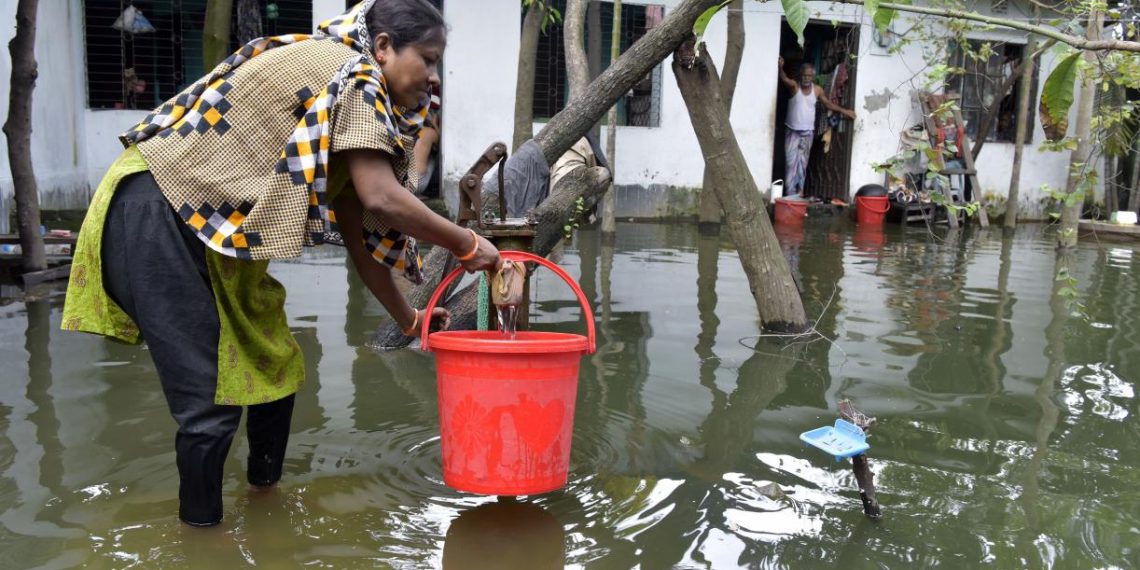We are already seeing the effects of climate change around the world in the form of severe floods, long-term droughts, worsening forest fires and more. It’s essential that communities invest in reducing and avoiding these impacts. For example, improved building methods can be the difference between a house withstanding a storm or crumbling to rubble.
The question is: How do we pay for it?
This is where adaptation finance comes in.
Particularly in low-income countries, adaptation finance is sorely needed to help make people — and the infrastructure and ecosystems they rely on — more resilient to the impacts of climate change. With each passing year, the need for greater adaptation finance is increasingly urgent.
But there are varying definitions about what counts as adaptation finance, as well as different means of providing and tracking funds. Here, we answer key questions:
1) What is adaptation finance?
Adaptation finance is finance for actions that help communities reduce the risks they face and harm they might suffer from climate hazards like storms or droughts. It pays for things like stronger housing, more drought-tolerant crops, social safety nets, or improved decision-making around climate-related risks.
Adaptation finance includes both finance from developed to developing countries (which can help fulfill the $100 billion wealthy nations committed to pay annually from 2020-2025), as well as finance that governments — both developing and developed — invest to cover the costs of climate change impacts within their own borders. Adaptation finance can also come from private sources.
2) Why is adaptation finance difficult to track?
For one, adaptation finance can be tricky to define in large part because adaptation is very context-specific. Unlike mitigation finance, which always focuses on reducing greenhouse gas (GHG) emissions, adaptation requires a broad array of activities tailored to particular climate risks facing a specific location.
There are also varying methods for tracking adaptation finance. Two of the most widely used approaches — OECD DAC Rio Markers and MDB Joint Methodology for Tracking Adaptation Finance — provide guidance to financial institutions and countries providing adaptation finance. While their methodologies differ somewhat, both focus on identifying whether an investment has supported climate resilience, and if so, to what degree.
Some countries have also created their own approaches to tracking adaptation finance and budget expenditures. These often draw from the two methodologies mentioned above, but make modifications to suit national circumstances. As a result, adaptation finance provided or received by countries is not always easily comparable.
Adaptation finance from the private sector is even more difficult to keep track of because, unlike public funding, governments do not maintain a centralized systems accounting for private funds . As a result, virtually no country currently monitors how much private funding is spent on adaptation within or outside its borders.
3) How is adaptation finance different from development finance?
Adaptation finance can often be very similar to other types of development finance. This is because support aimed at reducing communities’ economic or social vulnerability will often also have a positive impact on their resilience to climate change. To be counted as adaptation finance, though, funding should be provided with the express intention of enhancing climate resilience, based on analysis of climate risks.
Building a road may enhance resilience for a community by making it easier for people to access markets, hospitals, and other sources of assistance during extreme weather and other times of trouble. To count as adaptation finance, however, the road needs to be deliberately built with climate impacts and the needs of vulnerable people in mind. For example, a vulnerability analysis could reveal the need for a more durable road so people living in informal settlements can safely evacuate ahead of severe storms. The road would need to be sited where it will not be directly exposed to storm surges and erosion, or it should be elevated so that it remains passable when flooding occurs. Unless these kinds of conditions are met, funding for the road would count as development finance, but not adaptation finance.
4) How much adaptation finance is needed?
The difficulties of clear definitions and accurate data collection limit how precisely we can estimate adaptation finance needs. Uncertainties about future climate trajectories also complicate estimates, since how much adaptation finance the world needs depends in part on the success of efforts to reduce emissions.
But there are several studies that together give a general sense of how much adaptation finance developing countries will need. For example, the UNEP Adaptation Finance GAP Report estimates that adaptation finance needs in developing countries will reach $140 billion-$300 billion per year by 2030, and $280 billion to $500 billion per year by 2050. The International Monetary Fund (IMF) estimates that financial needs for adaptation exceed 1% of GDP per year in about 50 low-income and developing economies, rising up to 20% of GDP for small island nations exposed to tropical cyclones and rising seas.
5) How much adaptation finance is available?
Even with fairly limited data, it’s clear there’s not enough adaptation finance available to meet countries’ needs — and the gap is set to increase as climate change impacts intensify.
Climate Policy Initiative (CPI) estimates that less than $50 billion is spent around the world today on adaptation every year, many times less than what’s needed. Adaptation finance has increased in recent years relative to finance for mitigation, but still represents less than 10% of climate investments according to CPI. In terms of funding to reach the $100 billion goal, developed countries provided $28.6 billion in adaptation finance annually during 2016-2020, according to OECD, 34% of the total funding provided to date.
6) Why does mitigation receive more funding than adaptation?
There are several reasons why mitigation receives more finance than adaptation. Mitigation’s focus on GHG emissions not only makes it easier to define, it also makes it easier to invest in. Mitigation activities, like installation of solar panels or manufacturing of electric vehicles, bring a more immediate and certain financial return than many adaptation initiatives, which focus on building long-term resilience.
Meanwhile, carbon markets, which currently provide investment incentives for mitigation, do not exist for adaptation.
7) What about private sector finance for adaptation?
Private sector finance for adaptation is especially difficult to track. But based on the data that is available, private investment in adaptation is particularly limited. For example, of the adaptation finance that the Climate Policy Initiative has been able to track, on average around $300 billion in private finance has gone to mitigation and only $1 billion to adaptation.
There are several reasons behind limited private investments in adaptation. Adaptation projects often bring broad social benefits, but may not result in clear financial returns for a private investor. Many vulnerable communities are also located in areas perceived as too risky for private investment, including areas suffering from conflict or other forms of instability. Other times, private investments in resilience are not taking place simply due to inertia and a lack of long-term planning, technical capacity and data.
Private investment in adaptation needs to scale up because public funding alone will not meet the large and growing need for funds. Private companies finance, build and maintain vital infrastructure, supply chains and markets. It is essential that they integrate climate resilience into their investment decisions and explore innovative financial instruments to expand collaboration with the public sector in critical areas.
8) What form is adaptation finance taking?
The majority of adaptation finance (around 62%, based on OECD figures) is provided in the form of loans rather than grants, and this percentage has been slowly increasing over the last five years. This is problematic, since making debt payments is challenging for many countries and adding further debt could exacerbate the situation. Some countries have opted to turn down loans for climate-related activities to avoid adding further debt to their balance sheets.
9) Who is — and is not — receiving adaptation finance?
Evidence shows that available finance is not reaching those most vulnerable to climate impacts and who often have the fewest resources with which to adapt. According to the OECD, middle-income countries received 70% of the climate finance provided and mobilized by developed countries. Data from the four major multilateral climate funds — Adaptation Fund, Climate Investment Fund, Green Climate Fund and Global Environment Facility — indicate that fragile and highly vulnerable countries are receiving less finance than other states.
One potential reason for this skewed distribution of funding is that accessing adaptation finance often requires a significant amount of capacity. While requirements vary based on the type of finance involved, countries generally have easier access to finance if they have strong institutions in place with the manpower, data and know-how necessary to structure bankable adaptation initiatives that meet often complex funding requirements. Least developed countries often lack these resources, despite having the highest need for adaptation finance.
10) What is the relationship between adaptation finance and finance for loss and damage?
Funding for “loss and damage” is an important discussion point in climate negotiations. The idea of loss and damage is that wealthy nations should help pay for losses that developing countries incur due to the impacts of climate change — things like loss of significant portions of land to sea level rise, or loss of infrastructure to extreme weather events. Governments are still working out a more precise scope, including when, how and through what channels and instruments this kind of finance should be disbursed.
But it is clear that there is a close relationship between finance for loss and damage and funding for adaptation. Both aim to help communities deal with the costs associated with climate impacts. The main difference between the two is that adaptation finance is meant to help communities prepare for and reduce potential impacts, while loss and damage could primarily pay for losses that occur despite investments in resilience.
These distinctions and scope are important elements of UN climate negotiations, including at COP27 in November 2022.
11) What are important steps for increasing adaptation finance?
Several steps are needed to increase adaptation finance, from stronger political commitments to strengthened institutional capacity in public and private sectors. Better analysis and understanding of climate risks is also essential to increasing the level of finance available for adaptation.
Two kinds of measures would help: first, better measures of the economic and social risks posed by climate change; and second, better measures of the financial and economic returns on investments designed to reduce those risks. Combined, these measures would help countries, donors and the private sector agree on adaptation priorities, track adaptation finance, and integrate adaptation priorities into national planning.



